Related Research Articles

Portland is a port city in the Pacific Northwest and the most populous city in the U.S. state of Oregon. Situated in the northwestern area of the state at the confluence of the Willamette and Columbia rivers, Portland is the county seat of Multnomah County, the most populous county in Oregon. As of 2020, Portland had a population of 652,503, making it the 26th-most populated city in the United States, the sixth-most populous on the West Coast, and the second-most populous in the Pacific Northwest, after Seattle. Approximately 2.5 million people live in the Portland–Vancouver–Hillsboro, OR–WA metropolitan statistical area, making it the 25th most populous in the United States. About half of Oregon's population resides within the Portland metropolitan area.

Chinatown is the catch-all name for an ethnic enclave of Chinese people located outside Greater China, most often in an urban setting. Areas known as "Chinatown" exist throughout the world, including Europe, Asia, Africa, Oceania, and the Americas.

Salem is the capital city of the U.S. state of Oregon, and the county seat of Marion County. It is located in the center of the Willamette Valley alongside the Willamette River, which runs north through the city. The river forms the boundary between Marion and Polk counties, and the city neighborhood of West Salem is in Polk County. Salem was founded in 1842, became the capital of the Oregon Territory in 1851, and was incorporated in 1857.

Manhattan's Chinatown is a neighborhood in Lower Manhattan, New York City, bordering the Lower East Side to its east, Little Italy to its north, Civic Center to its south, and Tribeca to its west. With an estimated population of 90,000 to 100,000 people, Chinatown is home to the highest concentration of Chinese people in the Western Hemisphere. Manhattan's Chinatown is also one of the oldest Chinese ethnic enclaves. The Manhattan Chinatown is one of nine Chinatown neighborhoods in New York City, as well as one of twelve in the New York metropolitan area, which contains the largest ethnic Chinese population outside of Asia, comprising an estimated 893,697 uniracial individuals as of 2017.

Salem is a historic coastal city in Essex County, Massachusetts, United States, located on the North Shore of Greater Boston. Continuous settlement by Europeans began in 1626 with English colonists. Salem was one of the most significant seaports trading commodities in early American history.

The Chinatown–International District of Seattle, Washington is the center of the city's Asian American community. Within the district are the three neighborhoods known as Chinatown, Japantown and Little Saigon, named for the concentration of businesses owned by people of Chinese, Japanese and Vietnamese descent, respectively. The geographic area also once included Manilatown.
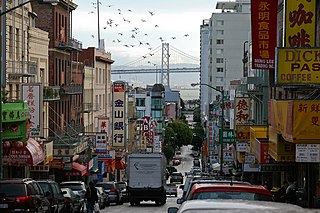
The Chinatown centered on Grant Avenue and Stockton Street in San Francisco, California, is the oldest Chinatown in North America and one of the largest Chinese enclaves outside Asia. It is also the oldest and largest of the four notable Chinese enclaves within San Francisco. Since its establishment in the early 1850s, it has been important and influential in the history and culture of ethnic Chinese immigrants in North America. Chinatown is an enclave that has retained its own customs, languages, places of worship, social clubs, and identity.

Chinatown is a neighborhood in Downtown Los Angeles, California, that became a commercial center for Chinese and other Asian businesses in Central Los Angeles in 1938. The area includes restaurants, shops, and art galleries, but also has a residential neighborhood with a low-income, aging population of about 7,800 residents.
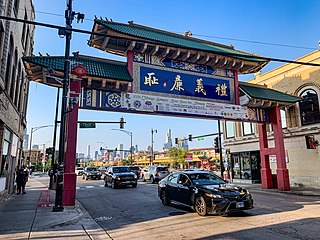
Chinatown is a neighborhood on the South Side of Chicago, along S. Wentworth Avenue between Cermak Road and W. 26th St. Over a third of Chicago's Chinese population resides in this ethnic enclave, making it one of the largest concentrations of Chinese-Americans in the United States. It formed around 1912, after settlers moved south from near the Loop, where the first enclaves were established in the 19th century.

Chinatown is a subzone and ethnic enclave located within the Outram district in the Central Area of Singapore. Featuring distinctly Chinese cultural elements, Chinatown has had a historically concentrated ethnic Chinese population.

The Chinatown neighborhood in Oakland, California, is traditionally Chinese which reflects Oakland's diverse Chinese American, and more broadly Asian American community. It is frequently referred to as "Oakland Chinatown" in order to distinguish it from nearby San Francisco's Chinatown. It lies at an elevation of 39 feet.

Philadelphia Chinatown is a predominantly Asian American neighborhood in Center City, Philadelphia, Pennsylvania, United States. The Philadelphia Chinatown Development Corporation supports the area. The neighborhood stretches from Vine Street on the north; Arch Street on the south; North Franklin Street and North 7th Street on the east; to North Broad Street on the west.

Downtown Portland is the central business district of Portland, Oregon, United States. It is on the west bank of the Willamette River in the northeastern corner of the southwest section of the city and where most of the city's high-rise buildings are found.

Two Bridges is a neighborhood in the New York City borough of Manhattan, nestled at the southern end of the Lower East Side and Chinatown on the East River waterfront, near the footings of Brooklyn Bridge and of Manhattan Bridge. The neighborhood has been considered to be a part of the Lower East Side for much of its history. Two Bridges has traditionally been an immigrant neighborhood, previously populated by immigrants from Europe, and more recently from Latin America and China. The Two Bridges Historic District was listed in the National Register of Historic Places in September 2003.

Chinatowns are enclaves of Chinese people outside of China. The first Chinatown in the United States was San Francisco's Chinatown in 1848, and many other Chinatowns were established in the 19th century by the Chinese diaspora on the West Coast. By 1875, Chinatowns had emerged in eastern cities such as New York City, Boston, and Philadelphia. The Chinese Exclusion Act of 1882 barred Chinese immigration to the United States, but the Magnuson Act of 1943 repealed it, and the population of Chinatowns began to rise again. In the 2010s, the downturn in the U.S. economy caused many Chinese Americans to return to China.
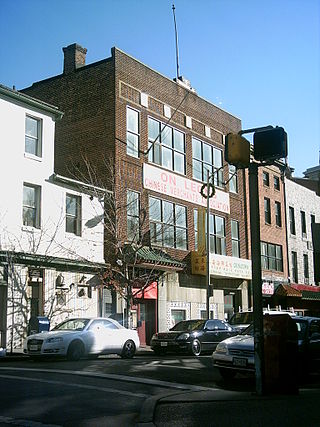
The U.S. city of Baltimore, Maryland is home to a small Chinatown. Historically, Baltimore had at least two districts that were called "Chinatown" where the first one existed on the 200 block of Marion Street during the 1880s. A second and current location is at the 300 block of Park Ave., which was dominated by laundries and restaurants. The initial Chinese population came because of the transcontinental railroad, however, the Chinese population never exceeded 400 as of 1941. During segregation, Chinese children were classified as "white" and went to the white schools. Chinatown was largely gone by the First World War due to urban renewal. Although Chinatown was largely spared from the riots of the 1960s, most of the Chinese residents moved to the suburbs. As of 2009, the area still shows signs of blight and does not have a Chinese arch. As of 2017, the area has become an “immigration hub” for Ethiopian people. In 2018, a mural of a Chinese dragon and an African lion was painted to signify the past as a Chinatown and the present as an African neighborhood. A night market in September 2018 marked the first Asian celebration of the area to an area that was “long forgotten and neglected”.

A Chinatown developed in Phoenix in the 1870s as the predominantly single male Chinese population self-segregated primarily to provide cultural support to each other in a place where they faced significant discrimination. They came to dominate certain types of jobs and made an impression on the greater community with their celebrations of Chinese holidays. Other aspects of their culture, primarily gambling and the smoking of opium were viewed less favorably, and in the 1890s, they were forced to establish a new Chinatown several blocks away from the prior prime downtown location, where their community would be "less visible".
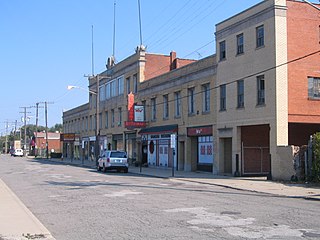
Asiatown, also spelled AsiaTown and formerly known as Chinatown, is a Chinatown located in Cleveland, Ohio, in the United States. Chinese people, brought to the country as railroad workers, established the area in the 1860s. The area became known as Chinatown in the 1920s, and was then centered at Rockwell Avenue and E. 22nd Street. Large numbers of non-Chinese people from Asia settled in the area in the 1960s and 1970s, leading to the enclave's expansion eastward. The expanded enclave was named Asiatown in 2006, with that portion on Rockwell Avenue often being referred to as "Old Chinatown" or "Historic Chinatown".
As of 2012, 21.4% of the population in San Francisco was of Chinese descent, and there were at least 150,000 Chinese American residents. The Chinese are the largest Asian American subgroup in San Francisco. San Francisco has the highest percentage of residents of Chinese descent of any major U.S. city, and the second largest Chinese American population, after New York City. The San Francisco Area is 7.9% Chinese American, with many residents in Oakland and Santa Clara County. San Francisco's Chinese community has ancestry mainly from Guangdong province, China and Hong Kong, although there is a sizable population of ethnic Chinese with ancestry from other parts of mainland China and Taiwan as well.
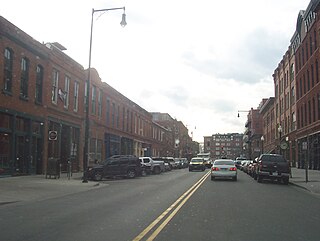
Chinatown in Denver, Colorado, was a residential and business district of Chinese Americans in what is now the LoDo section of the city. It was also referred to as "Hop Alley", based upon a slang word for opium. The first Chinese resident of Denver, Hong Lee, arrived in 1869 and lived in a shanty at Wazee and F Streets and ran a washing and ironing laundry business. More Chinese immigrants arrived in the town the following year. Men who had worked on the construction of the first transcontinental railroad or had been miners in California crossed over the Rocky Mountains after their work was completed or mines were depleted in California.
References
- 1 2 "Salem's Chinese Americans", Salem online history, Salem Public Library, retrieved 2017-10-09
- ↑ Oharazeki, Kazuhiro (2016), Japanese Prostitutes in the North American West, 1887-1920, University of Washington Press, p. 101, ISBN 9780295806686
- ↑ Mauldin, Frank (2004), Sweet Mountain Water: The Story of Salem, Oregon's Struggle to Tap Mt. Jefferson Water and Protect the North Santiam River, Oak Savanna Publishing, p. 245, ISBN 0974866806
- ↑ Capi Lynn (September 30, 2017), "Chinese shrine rediscovered, again, at Salem's Pioneer Cemetery", Statesman Journal , Salem, Oregon